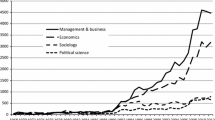Abstract
In this paper it is argued that evolutionary economics needs general statistical tools for performing the analysis of the aggregate effects of evolution in terms of the underlying population dynamics. These tools have been developed within biometrics, and they have recently become directly applicable to economic evolution due to the development of what may be called a general evometrics. Central to this evometrics is a method for partitioning evolutionary change developed by George Price into the selection effect and what may be called the innovation effect. This method serves surprisingly well as a means of accounting for evolution and as a starting point for the explanation of evolution. The applications of Price’s equation cover the partitioning and analysis of relatively short-term evolutionary change within individual industries as well as the study of more complexly structured populations of firms. By extrapolating these applications of Price’s evometrics, the paper suggests that his approach may play a central role in the emerging evolutionary econometrics.
Similar content being viewed by others
References
Andersen, E. S. (2002) “Railroadization as Schumpeter’s standard example of capitalist evolution: An evolutionary-ecological interpretation,” Industry and Innovation 9: 41–78.
Axelrod, R. (1990) The Evolution of Cooperation, reprint edn., Penguin, London.
- (1997) The Complexity of Cooperation, Princeton University Press, Princeton, N.J.
- and W. D. Hamilton (1981) “The evolution of cooperation,” Science 211: 1390–1396.
Bartelsman, E. J. and M. Doms (2000) “Understanding productivity: Lessons from longitudinal microdata,” Journal of Economic Literature 38: 569–594.
Boyd, R., H. Gintis, S. Bowles and P. J. Richerson (2003) “The evolution of altruistic punishment,” Proceedings of the National Academy of Sciences 100: 3531–3535.
Dopfer, K. (ed) (2001) Evolutionary Economics: Program and Scope, Kluwer, Boston, Mass.
Fisher, R. A. (1999) The Genetical Theory of Natural Selection: A Complete Variorum Edition, Oxford University Press, Oxford.
Foster, J. and J. S. Metcalfe (eds) (2001) Frontiers of Evolutionary Economics: Competition, Self-Organization and Innovation Policy, Elgar, Cheltenham and Northampton, Mass.
Frank, S. A. (1995) “George Price’s contributions to evolutionary genetics,” Journal of Theoretical Biology 175: 373–388.
- (1997) “The Price equation, Fisher’s fundamental theorem, kin selection, and causal analysis,” Evolution 51: 1712–1729.
- (1998) Foundations of Social Evolution, Princeton University Press, Princeton, N.J.
Freeman, C. and F. Louca (2001) As Time Goes By: From the Industrial Revolutions to the Information Revolution, Oxford University Press, Oxford.
Gifford, A. (2000) “The bioeconomics of cooperation,” Journal of Bioeconomics 2: 153–168.
Gintis, H. (2000) Game Theory Evolving: A Problem-Centered Introduction to Modelling Strategic Behavior, Princeton University Press, Princeton, N.J.
Hamilton, W. D. (1996) The Narrow Roads of Gene Land: The Collected Papers of W. D. Hamilton, Freeman, Oxford.
Henrich, J. (2004) “Cultural group selection, coevolutionary processes and large-scale cooperation,” Journal of Economic Behavior and Organization 53: 3–36.
Knudsen, T. (2002) “Economic selection theory,” Journal of Evolutionary Economics 12: 443–470.
- (2004) “General selection theory and economic evolution: The Price equation and the genotype/phenotype distinction,” forthcoming in Journal of Economic Methodology.
MacArthur, R. H. and E. O. Wilson (2001) The Theory of Island Biogeography, reprint edn., Princeton University Press, Princeton, N.J. and Oxford.
Malerba, F., R. R. Nelson, L. Orsenigo and S. G. Winter (1999) “‘History-friendly’ models of industry evolution: The computer industry,” Industrial and Corporate Change 8: 1–36.
Marshall, A. (1949) Principles of Economics: An Introductory Volume, reprint of the 8th edn., Macmillan, Basingstoke and London.
Maynard, S. J. (1982) Evolution and the theory of games, Cambridge University Press, Cambridge.
Maynard, S. J. and G. R. Price (1973) “The logic of animal conflict,” Nature 245: 15–18.
Malerba, F., R. R. Nelson, L. Orsenigo and S. G. Winter (1999) “‘History-friendly’ models of industry evolution: The computer industry,” Industrial and Corporate Change 8: 1–36.
Metcalfe, J. S. (1994) “Competition, Fisher’s Principle and Increasing Returns in the Selection Process,” Journal of Evolutionary Economics 4: 327–346.
- (1998) Evolutionary Economics and Creative Destruction, Routledge, London and New York.
- (2001) “Evolutionary approaches to population thinking and the problem of growth and development,” in K. Dopfer (ed) Evolutionary Economics: Program and Scope, Kluwer, Boston, Mass.
Metcalfe, J. S. (2002) “Book review: Steven A. Frank. 1998. Foundations of Social Evolution”, Journal of Bioeconomics 4: 89–91.
Nelson, R. R. (1995) “Recent evolutionary theorizing about economic change,” Journal of Economic Literature 33: 48–90.
Nelson, R. R. and S. G. Winter (1982) An Evolutionary Theory of Economic Change, Belknap/Harvard University Press, Cambridge, Mass. and London.
Page, K. M. and M. A. Nowak (2002) “Unifying evolutionary dynamics,” Journal of Theoretical Biology 219: 93–98.
Price, G. R. (1970) “Selection and covariance,” Nature 227: 520–521.
- (1972a) “Extension of covariance selection mathematics,” Annals of Human Genetics 35: 485–490.
- (1972b) “Fisher’s ‘fundamental theorem’ made clear,” Annals of Human Genetics 36: 129–140.
- (1995) “The nature of selection,” Journal of Theoretical Biology 175: 389–396.
Schumpeter, J. A. (1939) Business Cycles: A Theoretical, Historical, and Statistical Analysis of the Capitalist Process, McGraw-Hill, New York and London.
- (1954) History of Economic Analysis, (ed. E. B. Schumpeter), Allen and Unwin, London.
Author information
Authors and Affiliations
Corresponding author
About this article
Cite this article
Andersen, E.S. Population Thinking, Price’s Equation and the Analysis of Economic Evolution. Evolut Inst Econ Rev 1, 127–148 (2004). https://doi.org/10.14441/eier.1.127
Published:
Issue Date:
DOI: https://doi.org/10.14441/eier.1.127




